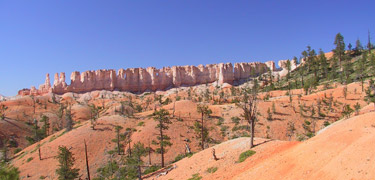Photo Courtesy
Utah Geological Survey
Hi, I’m Holly Strand for Stokes Nature Center in beautiful Logan Canyon.
Mongolia, China, and United States have produced far more dinosaur fossils than any other countries in the world. And Utah is a prime dinosaur site within the United States. Scattered around Utah are several active quarries, including the world famous Carnegie Quarry in Dinosaur National Monument and the Cleveland-Lloyd Dinosaur Quarry outside of Price. Paleontologists are beginning to find that the Grand Staircase Escalante Area is another prolific boneyard. In their day, dinosaurs roamed almost all parts ofthe known world, so what makes Utah so exceptional for dinosaur discoveries?
First of all, it’s important to understand that the vast majority of dinosaurs lived and died without leaving any fossil traces. Thus, what we find today is an extremely small percentage of the total of all dinosaur matter. In order to be preserved a creature needs to be buried or frozen almost immediately upon death, Given that the world was pretty warm in the age of the dinosaurs, most of today’s fossils come from individuals that died in or near a sand dune, lake or sea and were then quickly covered by sand or mud. Dinosaurs lived in the late-Triassic, Jurassic and Cretaceous periods of the Mesozoic era –that is 225-65 million years ago. At that time, what-would-be-become Utah featured both a shallow inland sea and dunes.. So dinosaurs who lived and died here had a much better chance of being fossilized.
Once fossils are well preserved, certain conditions will increase the probability that they will be found. First of all, you want exposed Mesozoic rock, since dinosaurs lived and died in the Mesozoic era. The Morrison and Cedar Mountain Formation are both from the Mesozoic and are extremely rich in dinosaur fossils.. In fact, Utah has one of the most detailed Mesozoic rock records in the world. Certain types of sedimentary rock –including sandstones, mudstones and limestones –are most promising for fossils and Utah has plenty of these.
Another condition for good fossil hunting is a dry environment. Desert and semi-deserts are optimal for discovery, since decomposition is slowed. With little or no vegetation on the ground, wind and water erosion increases and more ancient fossils are uncovered. In this regard also, Utah is perfect, having just the right amount of water. There’s enough to cause occasional and severe erosion to expose new rock, but not enough to encourage the amount of plant growth that will anchor soil or reduce visibility of the ground.
In the past 2 decades, dinosaur discovery and research has been enjoying a renaissance with plenty of new species being unearthed.. In an upcoming episode, I”ll talk about some exciting new discoveries in our state.
For Wild About Utah and Stokes Nature Center, I’m Holly Strand.
Credits:
Photo: Courtesy Geology.Utah.gov, https://geology.utah.gov/esp/paleo/images/dinodig.jpg
Text: Stokes Nature Center – Holly Strand
Sources & Additional Reading
Dodson, Peter. 1990. Counting dinosaurs: How many kinds were there? Proc. Natl. Acad. Sci USA. Evolution. Vol 87, pp. 7608-7612.
Handwerk, Brian. 2008. Amazing Dinosaur Trove Discovered in Utah National Geographic News June 17
Norman, David. 2005. .Dinosaurs A Very Short Introduction. Oxford Univ. Press
Utah Geological Survey/Dinosaurs and Fossils. https://geology.utah.gov/utahgeo/dinofossil/index.htm (accessed Sept 12, 2008)


